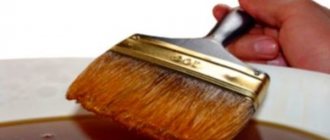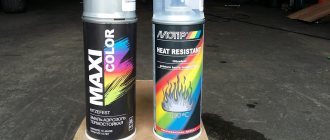Creating a cozy home interior is the basis of any home construction, and working with wood is an integral part of it. This is a special type of finishing that requires certain knowledge and skills. Wood processing includes not only sanding and decorating, but also protecting the natural material. Drying oil can not only protect wood from damage by parasites, but also give it a unique “warmth”, creating an ideal home interior.
Natural drying oil is used for diluting thick oil paints for interior decoration. Wooden surfaces are impregnated with it to protect against external factors. Drying oil also plays the role of plaster before treating wood with oil paints. High-quality drying oil is good for both internal and external work.
DIY drying oil from sunflower oil
Currently, when arranging buildings, various options for finishing materials are used. Basically, the purpose here is to extend the service life of structural elements. To treat a wooden surface, such a common treatment option as drying oil is often used. A well-known and sought-after composition that significantly extends the service life of wooden structures, however, few know that this substance can be prepared (cooked) independently from vegetable oil. In this case, we will consider how to make drying oil yourself from sunflower oil.
Scope of application of natural drying oil
The use of natural drying oil is in one way or another connected with the processing of wood and the preparation of products for its finishing. It is used as an independent product, as a base for oil paint, for the preparation of putties and primers.
The scope of application of drying oil is very wide:
- Processing of wooden interior elements - floors, window frames, window sills, ceilings, baseboards, doors, etc.
- Priming surfaces before painting to increase adhesion and reduce paint consumption.
- Production of putties, thickly rubbed paints, pastes, putties and primers;
- Protection of wood from rotting, moisture and pests in the structure of boats and small vessels;
- Dilution of paints, primers, putties and other coatings;
- Antiseptic treatment of logs and beams during the construction of log houses and other similar structures.
- Repair of coatings and restoration of furniture;
- Finishing of parquets, floorboards and their care;
- Making bee hives.
What is the difference between drying oil and other antiseptics, which also prevent wood from rotting and molding? The difference is that drying oil keeps the wood dry, while other antiseptics are simply toxins for bacteria and fungi. That is, when treated with chemicals, the wood still gets wet, it’s just that now it’s poisoned from the point of view of parasites, and they don’t eat it.
When drying oil is used for painting before applying the base coat, it leads to such effects as improved adhesion of paint to the surface, uniform coloring, improved appearance of the coating and extension of its service life. This effect is used in the manufacture and restoration of furniture, lining, parquet and other similar coatings.
We can say that natural drying oil is used in the field of wood processing and the preparation of materials for finishing work. This is an absolutely safe natural material that has a light, pleasant scent of linseed oil. After application, it penetrates deep inside and fills all pores and capillaries, evenly painting the surface. As a result, the material becomes insensitive to moisture and the destructive factors of biological corrosion.
Making drying oil from sunflower oil at home
Few people know that drying oil can be prepared with your own hands, and in the manufacturing process you do not need to resort to complex technologies. In order to make drying oil from oil at home, you will need to do the following series of sequential actions:
- You will first need to prepare all the ingredients for manufacturing, as well as an auxiliary tool.
- Next, you have to choose the appropriate option for preparing this substance for wood processing.
- The next step is mixing the components and subsequent cooking of the substance under appropriate conditions for a specific time.
- At the end, you just have to cool this composition, then mix it thoroughly and use it for application to the surface.
In itself, the process of boiling old drying oil or a fresh composition from the appropriate components is not particularly difficult; the main thing here is to follow the technology, and in addition, adhere to a specific recipe for implementation.
Important. The cooking procedure for this substance involves the release of a strong and unpleasant odor, which will require you to open a window if the process takes place indoors, otherwise you may get poisoned.
Advantages and disadvantages
In practice, making this component yourself has a number of advantages, but there are also some disadvantages. Let's take a closer look at the main advantages of the process:
- here you can save a lot of money, since high-quality material has a sufficient cost;
- if necessary, it will be possible to use up all the old oil that is present and unsuitable for food use;
- you can independently prepare a high-quality composition, which in terms of characteristics will not be inferior to purchased options;
- It is possible to supplement the prepared composition with auxiliary properties through special processing.
Despite some advantages, it cannot be said that such a process is considered acceptable, since there are a number of disadvantages. When cooking, a pungent, unpleasant odor is released. It is necessary to maintain a certain technology, otherwise nothing positive will come of it. Appropriate equipment is required to carry out the work.
Important. Everyone evaluates the presence of pros and cons for themselves, but it should be added that on a large scale this is not advisable due to material and time costs.
DIY methods for making drying oil
In order to produce this substance, there is a technology of cold cooking and hot cooking. In each individual case, the process has similar aspects, and in addition specific differences. Let's take a closer look at the provided cooking technologies:
- Hot cooking. The drier is first ground with an oil base (dehydrated) in equal proportions. The mixture is heated to 170 degrees. A mixed drier is added (2% of the volume). If foam does not stand out, increase the temperature to 280 degrees. Cook for 4 hours, then allow the mixture to cool and thicken.
- Cold cooking. It is required to mix the drier with the oil base. The filtered base is heated to 120-150 degrees. The mixture is stirred and the drier is added. When foaming increases, mixing must be accelerated. When the separation is complete, the substance will be ready and will have to cool.
In practice, any cooking option can be used, but it should be understood that hot cooking is not always possible due to the technical equipment present or limitations.
Tips and tricks for making
In order to make a high-quality solution, you will need to take into account the following expert advice:
- it is necessary to adhere to a minimum amount of foam;
- it is necessary to check the composition for thickness;
- It is better to use a respirator during the cooking process;
- When cooking, do not cool the substance;
- It is necessary to stir the composition to prevent excessive thickening.
Taking these tips into account, it is possible to prepare a high-quality composition that is perfect for processing wooden structures.
Important. For cooking, you will need to select a container that you will not subsequently need to use for cooking.
How to make linseed oil?
Drying oil (oil) is often used during finishing work as a primer or paint thinner. If for some reason you don’t have factory-made drying oil on hand, you can make this product yourself at home. This product is made from vegetable fat, usually flaxseed or sunflower oil.
Linseed oil drying oil
To make linseed oil you will need the following equipment:
- metal utensils (basin, ladle, plate, pan, etc.);
- heating device (kerosene stove, gas or electric stove);
- rosin;
- manganese peroxide;
- respirator and gloves.
Pour oil into a vessel and heat over low heat. Upon reaching 110 degrees, the oil will begin to release water - this will be noticeable to the eye. Next, the process of water evaporation begins. In this case, you need to ensure that the temperature of the liquid does not cross the line of 160 degrees. The oil should be boiled for 4 hours.
Note! Drying oil is a fire hazard, so do not pour too much oil into the container. It is enough to fill half the vessel.
After the water has evaporated and foam has formed, you can add a drier based on the following proportion: 30-40 grams of the substance per liter of oil. When adding a drier, a lot of foaming occurs, so the work must be done with extreme caution, adding the substance gradually.
When the drier is added, increase the temperature to 200 degrees and continue to cook the mixture for 3 hours. The readiness of the composition is checked as follows: a drop of the substance is placed on the glass, and if it is transparent, the solution is ready. Next, the composition is cooled at room temperature.
A drier is an auxiliary substance that affects the drying speed of drying oil. This component is included in oil paints, where it is responsible for the same property.
To make a drier, you need to mix rosin with manganese peroxide based on a ratio of 20 to 1. First, bring 20 parts of rosin to a state of melting at a temperature of 150 degrees above zero, and then add 1 part of manganese peroxide.
Drying oil from sunflower oil
A composition made from sunflower oil will protect the surface just as reliably as one made from linseed oil. The only difference is that the color of the product will be lighter, which can be used, for example, for the design of a room.
You can prepare drying oil in two ways - hot and cold. Hot cooking allows you to obtain particularly durable coatings on the surface being treated.
Whatever method of preparing the composition is chosen, the oil still needs to be processed thermally. When making drying oil, it is necessary to remove water from the composition, as well as oxidize all kinds of impurities.
Instructions for heat treatment of sunflower oil:
- Pour oil into a metal container. The oil should fill the dishes no more than 50-60%. Place the container on low heat.
- After the oil reaches a temperature of 110 degrees, abundant foaming and evaporation of water begins.
- Increase the temperature to 170 degrees and keep the oil on the fire for another 3-5 hours.
- After the water has completely evaporated, raise the temperature to 250-280 degrees. At this point, darkish flakes will begin to separate from the oil.
- Let the oil cool at room temperature, and then strain it through cheesecloth. The process of preparing the base for drying oil is complete.
Tip #1: You can determine whether the oil has heated to a temperature of 250-280 degrees using a goose feather. If the edges of the feather curl or deform, it means that the desired temperature has been reached.
Tip #2: to reduce foaming, it is recommended to add a little prepared drying oil at room temperature to a metal container.
Recipe for preparing the mixture using the cold method:
- Heat the prepared base to 120-150 degrees. In this case, the base must be constantly stirred.
- As soon as the desired temperature is reached, add a drier - its share in the oil solution should be 5-8%. For greater safety, it is recommended to first mix the drier with the same amount of oil, and only then add the mixture to the base. If, nevertheless, the foam is released very intensively, we reduce the rate of addition of the drier and vigorously mix the mass.
- After combining all the components, remove the container from the heat and cool the drying oil at room temperature.
Recipe for preparing the composition using the hot method:
- Heat the base to 170 degrees and add a drier at the rate of 1.5-2.5% of the volume of the base.
- Before adding the drier, mix it with dehydrated sunflower oil in equal quantities.
- As soon as foaming has decreased, we begin to increase the heating temperature to 280 degrees. At the same time, regularly stir the composition throughout the entire cooking process (about 4 hours).
Impregnation with drying oil
Methods for impregnating a wooden product:
- Treating wood with hot solution. Soaking is carried out in a water bath. This method is good for processing small parts. Place the wooden product in a bowl with hot drying oil for 4-8 hours. Then we wait for 4-6 days for the surface to dry completely. Please note: if you mix red lead (3-4% of the total volume) with drying oil, the quality of impregnation will significantly increase, and the surface will dry in just 2-3 days.
- Treatment with a solution of oil and kerosene. We combine the components in a ratio of 1 to 1. It is acceptable to use both cold and heated ingredients. However, the temperature of the solution will affect the speed of impregnation: the surface needs to be treated with hot drying oil for only 3 hours, but if the composition is cold, it will take 1-2 days.
- Treatment with a solution of oil, paraffin and turpentine. To prepare the solution you will need 40% drying oil, 8% turpentine and 52% paraffin. First, dissolve the paraffin using turpentine in a water bath. Then add drying oil and mix the mixture thoroughly. Apply the hot solution to the wood. The drying period will be from 2 to 3 days.
- Treatment with a solution of oil and wax. The solution is prepared based on the following proportions: 85% drying oil, 15% wax. Grind the wax and immerse it in the hot mixture. The drying time for the surface will be within 2-3 days.
Drying is a responsible job that does not end after treating the surface with drying oil. Before continuing to manipulate the wood, you need to wait until the coating is completely dry. The drying rate depends on several circumstances, including: the components of the solution used, the amount of drier, the type of wood and other factors.
Drying oils with driers based on polymetals dry the fastest. But monometallic driers do not promote rapid drying. For example, a surface treated with drying oil with lead drier will dry in 20 hours.
If lead is replaced with manganese, drying time will be reduced to 12 hours. An even better drying performance is achieved by combining lead and manganese into a polymetallic drier. In this case, the surface will dry in 7-8 hours.
Air humidity and temperature have a significant impact on drying speed. Drying oil with cobalt drying agent will dry 1.5 times faster when the air temperature rises to 25 degrees.
Under the same conditions, a solution with manganese drier dries 4 times faster. The optimal air humidity for drying the surface is 65-70%.
Drying oil substitute
This option is for those cases when it is not possible not only to purchase factory-made drying oil, but also to make it yourself at home.
Substitute recipe:
- casein - 50%;
- slaked lime - 25%;
- turpentine - 12.5%;
- soap solution - 7.5%.
Add turpentine after thoroughly mixing the other ingredients. Next, dilute the mixture with water until the solution looks like thick drying oil. To avoid the appearance of sediment, add a little ammonia to the composition.
A surface treated with casein solution dries faster than with drying oil. The composition can be added to oil paints to improve their strength and water-repellent characteristics.
See also:
- Pumping stations
- The water in the septic tank is frozen: what to do?
- What is the concrete mixture made of?
- Installation of water supply systems
- Concrete mixture manufacturing technology
- How does a septic tank for a summer house work?
chudoogorod.ru
Cooking old drying oil
In order to return the substance to the necessary viscosity and properties, it is recommended to heat treat the old version of the composition. Especially for this purpose, provision is made for preparing the container and then pouring in the solution. Next, you need to add a small amount of drying agent, while regularly stirring the drying oil so that it does not turn out to be too thick. During the cooking process, the temperature is maintained around 150-170 degrees. The whole procedure lasts up to 2 hours, and the composition should be constantly stirred. Finally, you need to let the ingredient cool before using it directly.
What are the ways to make drying oil with your own hands?
In order to make the composition yourself, you must have:
- Metal container (saucepan, ladle, etc.).
- Heating devices (for example, an electric stove).
- Resin.
- Manganese peroxide.
- Respirator or protective mask and gloves.
First, you need to pour the oil into a container yourself and put it on low heat. When it heats up to 110 degrees, water will begin to release.
Next, you need to let the water evaporate and carefully monitor the temperature of the composition; it should not exceed 150 degrees.
The solution must be boiled independently for four hours.
Note: since the mixture is a flammable substance, it is not recommended to pour it into the container to the very edge. It is enough to fill the vessel halfway.
After the water has completely evaporated and the foaming process is completed, a catalyst can be added to the container in proportions of 30/40 grams per 1 liter of oil.
The catalyst must be added in batches because it produces a very large amount of foam. After mixing the oil with the drier, you can increase the temperature to +200 degrees and leave the composition to boil for another three hours.
How to determine whether the mixture is ready or not yourself?
It is necessary to drop a small amount onto the glass. Its transparency indicates readiness.
Upon completion, leave the composition at room temperature to cool slightly.
The catalyst in this case is just an auxiliary element on which how quickly the drying oil dries depends.
To make this substance, you need to mix resin and manganese peroxide together in a ratio of 20:1 (where 20 is the number of parts of resin).
Before mixing, you must melt the rosin a little yourself at a temperature of +150 degrees.
Technical characteristics and composition of natural drying oil
The main purpose of the composition is, of course, to protect surfaces from various types of mechanical influences. Natural drying oil is intended, first of all, to maintain environmental standards (GOST 7931 76) of the product coated with drying oil.
Today people use several types of composition: natural (all components are environmentally friendly), semi-natural (a drier is added to the base to strengthen the technical characteristics of drying oil) and synthetic (usually added to paint coatings to increase the volume of paint and its ability to adhere).
Natural drying oil can be made from different components, that is, it can be based on: olive, sunflower, hemp oil. One of these substances is boiled and brought to a certain temperature. Dryers are added in accordance with the manufacturer's requirements: 35% per 1 liter of natural oil. This is necessary to prevent a fire in the house.
IMPORTANT. When pouring natural oil into a container, pour the mixture into half the pan, since when the temperature rises, the mass foams and rises, and, accordingly, a fire may occur, or you may receive serious burns.
Based on sunflower oil
This type is in no way inferior to the previous one in terms of quality and strength, the only difference is a lighter shade.
The composition can be prepared using cold or hot methods. The second of which helps to give the bases the highest level of strength.
However, regardless of the chosen method, the oil will be subjected to heat treatment.
Also, in order for the composition to be of truly high quality, it is necessary to remove water from it as much as possible and eliminate the oxidation of various impurities.
Algorithm for performing heat treatment yourself:
- To begin with, pour the oil into the prepared vessel (preferably halfway) and put it on low heat.
- As soon as the water begins to evaporate and foam forms, the oil has heated up to 110 degrees.
- After this, you need to independently increase the temperature to 170 degrees and boil the mixture for another three to five hours.
- After the water has completely evaporated, you need to independently increase the temperature, to about 260-280 degrees (in this case, the oil should darken and begin to release flakes).
- Upon completion, the oil should be cooled at room temperature, after which it should be strained through cheesecloth. That's all.
Recommendation #1: To determine whether the oil has actually reached the desired temperature, you can use a quill pen. If the temperature is 260 - 280 degrees, it will begin to darken and curl.
Recommendation No. 2. To prevent the formation of too much foam from the catalyst, it is recommended to add a small amount of the prepared mixture, slightly heated, to the solution.
Algorithm for cold manufacturing yourself:
- First you need to heat the base to a temperature of 130 - 150 degrees (stirring it constantly).
- Once the composition reaches the required temperature, a catalyst is added to it in a volume of 5-8 percent. It is recommended to first mix it with oil and only then add it to the base. If the foam continues to be released abundantly, you need to reduce the volume of added catalyst (and at the same time continue to vigorously mix the composition).
- Upon completion, allow the drying oil to cool naturally.
How to prepare drying oil
Drying oil can be freely purchased at a hardware store. But the huge selection is often misleading and leaves you guessing which product is of better quality. Using simple instructions, you can make drying oil with your own hands in your own kitchen. In this case, you will be confident in the naturalness of all the ingredients, and therefore in the quality of the drying oil itself.
Linseed oil drying oil
Previously, drying oil was made by cooking and exclusively linseed oil was used for this.
To prepare classic drying oil you will need:
• any metal vessel (plate, basin, ladle, pan);
• heating device (kerosene stove, gas or electric stove);
• linseed oil;
• rosin;
• manganese peroxide;
• gloves;
• respirator.
When preparing linseed oil, remember that the oil can ignite, so do not pour too much of it - 3/6 of the total volume is enough.
Pour oil into an iron container and heat over low heat. First you will see how the oil has released water. This happens when its temperature has not reached 110 degrees. After this, the water begins to evaporate. Make sure that the heating temperature does not exceed 160 degrees.
Flaxseed oil should be simmered over low heat at a temperature no higher than 160C for about 4 hours. When all the water has evaporated and foam stops forming, you can add a drier at the rate of 30-40 g/1 liter of oil. When introducing a drier, a lot of foam is formed, so this must be done as slowly and carefully as possible. After this, cook the mixture for several minutes over low heat and leave to cool at room temperature.
Drying agent or manganese resinate is a special auxiliary substance that promotes rapid drying of drying oil. It is also present in oil paints, performing the same function.
To prepare a drier, you need to mix rosin and manganese peroxide at a ratio of 100:5. First, 100 parts of rosin must be melted in a separate container at 150C, then gradually add 5 parts of manganese peroxide. Please note that the mixture will foam a lot, so each part of manganese should be added as the foam decreases. When all ingredients are mixed, increase temperature to 200C and cook for 3 hours. You can check the readiness of the drier by dropping it on the glass - if the drop is transparent, the process is complete.
Drying oil from sunflower oil
This drying oil is an excellent and widely available alternative to the flaxseed recipe. Just like natural wood, it leaves an elastic, durable film on the surface and perfectly protects the wood. The only thing is that the color of sunflower drying oil will be much lighter. This can be used for design tricks when creating a cozy interior. You can prepare such drying oil using two methods – cold and hot. In the second option, the film on wood is especially durable.
Regardless of the preparation method, sunflower oil must be heat treated. The removal of water from oil and the oxidation of impurities in its composition are an integral part of the process of cooking drying oil.
- Fill an iron container with oil to 3/5 of its volume and place on low heat.
- When the temperature reaches 110-120 degrees, foaming and dehydration will begin.
- Heat the oil, maintaining the temperature to 170 degrees for 3-5 hours.
- When the water has completely evaporated, increase the temperature to 280C. It will become visible how distinct dark flakes stand out from it.
- Cool the oil and strain through a filter (gauze, felt). The base for preparing drying oil is ready.
Helpful tip: to check if the oil has warmed up to 260-280C, dip a goose or pigeon feather into it. If the edges curl and shrink, you have reached the desired temperature. To “tame” the abundantly protruding foam, pour a little prepared cold drying oil into an iron container.
- The cold method is to heat the oil base to 120-150C and, stirring continuously, add a drier at the rate of 5-8% of the oil volume. To make the process as safe as possible, it is first better to mix the drier with an equal amount of the oil base, and only then add it to the main mass. If the foam is released too abundantly, reduce the speed of introduction of the drier and increase stirring. When the ingredients are combined, turn off the heat and cool the drying oil at room temperature.
- The hot method is to heat the oil base to 170C and carefully introduce the drier into it at the rate of 1.5-2% of the total mass. The drier must first be ground with an equal amount of dehydrated sunflower oil. When all the drier has been added and no more foam is released, heat the mixture to 280C. Continuously stirring the future drying oil, maintain the cooking temperature for about 4 hours until the desired degree of viscosity is obtained.
Wood treatment with drying oil
You can impregnate wood bases yourself using drying oil using several methods, namely:
- Using a hot solution. This means immersing the product in a vessel with heated drying oil for four to eight hours. Upon completion, you need to give the part time to dry (about four to six days). For greater effect and faster drying, you can mix drying oil with red lead in a proportion of 3-4 percent of the total mass.
- Using a mixture of oil and kerosene. To begin with, the components need to be combined in a 1:1 ratio. You can use cold or heated ingredients, this does not affect the quality. But, at the same time, the hotter the drying oil is during processing, the faster the surface will dry completely (about three hours), while after treatment with a cold composition the surface will dry within 1 - 2 days.
- Using mixed oil, paraffin and turpentine. The solution must be prepared independently in the following proportions: drying oil - 40%, turpentine - 8% and paraffin - 52%. First of all, you need to dissolve the paraffin in a water bath, then add drying oil to it and mix everything thoroughly. Next, you need to treat the wooden surface with the hot mixture and leave it to dry naturally for two to three days.
- Using a mixture of oil and wax. The mixture is made in the following proportions: drying oil - 85%, wax - 15%. First, you need to grind the wax and pour it into the heated mixture yourself. Afterwards treat the surface. The base will dry completely in about two to three days.
Treating wood surfaces is not limited to applying drying oil; this is just the beginning.
But before moving on to the next stage of work, you need to let the surfaces dry as well as possible.
How quickly this will happen depends on several factors, including the type of wood being worked with, the volume of catalyst used in the process of making the solution, the ingredients from which the mixture is made, and others.
Minimum drying time for surfaces coated with drying oil with catalysts made on the basis of polymetals.
While monometal-based driers even slow down this process to some extent.
For example, take the use of drying oil with a lead-based catalyst; the drying speed of such bases is approximately 20 hours.
If the catalyst is manganese, the drying time will be several times shorter - approximately 12 hours.
But the best result is obtained by drying oil with a polymetallic catalyst based on lead and manganese - approximately 7-8 hours.
How quickly the treated wooden surface dries is also influenced by the temperature and humidity level in the room where it actually dries. Drying oil with a cobalt catalyst dries approximately one and a half times faster, at a temperature of +25 degrees.
At this temperature, drying oil with a manganese catalyst dries completely four times faster.
The humidity level should be between 65 and 70%.
What is drying oil
Drying oil is a polymer film-forming substance created on the basis of alkyd resin or heat-treated vegetable oil. The main purpose of drying oil is to treat surfaces of unpainted wood, some types of metal and concrete. Externally, oil impregnation looks like an almost transparent liquid, the color of which varies from barely noticeable yellow to dark red.
The main purpose of drying oil is to treat surfaces of unpainted wood, some types of metal and concrete.
Alternative to drying oil
Replacing it with another substance should be used only when it is not possible to either purchase it or make it yourself.
The substitute is independently made from:
- 50% casein.
- 25% slaked lime.
- 12.5% turpentine.
- 7.5% soapy water.
First you need to mix all the ingredients except turpentine. Then you can add turpentine and pour water into the solution until the mixture begins to resemble viscous drying oil. Adding a small amount of ammonia to the solution will prevent the formation of a precipitate.
Surfaces treated with this composition on their own dry much faster than those impregnated with drying oil.
A solution prepared independently from casein can also be added to dyes in order to increase their level of strength and moisture resistance.
Drying oil substitute
This option is for those cases when it is not possible not only to purchase factory-made drying oil, but also to make it yourself at home.
Substitute recipe:
- casein - 50%;
- slaked lime - 25%;
- turpentine - 12.5%;
- soap solution - 7.5%.
Add turpentine after thoroughly mixing the other ingredients. Next, dilute the mixture with water until the solution looks like thick drying oil. To avoid the appearance of sediment, add a little ammonia to the composition.
A surface treated with casein solution dries faster than with drying oil. The composition can be added to oil paints to improve their strength and water-repellent characteristics.
Drying oils and oils for decorative finishing
High-quality vegetable oil for interior work allows you to make the decorative finish of some surfaces more textured and rich in color. When choosing oil for interior finishing, you should pay attention to its composition and production method. No refined petroleum products are used in residential premises, office buildings and shopping centers for finishing. During their entire subsequent “life,” they will actively release substances that are toxic to humans into the surrounding air. Therefore, when choosing oil for external and internal work, you should carefully study the instructions for the product and the manufacturer’s recommendations for use.
Some tips, including how to prepare drying oil with your own hands, can be found in this article.
What oils and drying oils are suitable for wood?
Most paints are diluted in oil, which can be of mineral, vegetable or animal origin. Mineral oils include petroleum, rock wax, etc.
In painting, oil and drying oil for wood are used exclusively of plant origin, extracted from the seeds of various plants and mainly flaxseed. You can find out which ones are suitable further in the article.
Vegetable oils are very diverse in their composition and are commercially available in solid (Japanese wax), thick (coconut oil) and liquid (linseed oil).
All vegetable oils when left in air for a long time oxidize, thicken and turn bitter.
Liquid and lubricating oils have the property of being viscous, harden and are able to form a beautiful elastic, rubber-like mass.
In addition, vegetable oils can be divided into drying and non-drying. The first include: flaxseed, nut, hemp, poppy, sunflower, etc.
The second: wood, olive, almond, rapeseed, rapeseed, mustard, beech, castor, etc.
Flaxseed oil is extracted by pressing flaxseeds. Cold pressing produces the best type of oil with a pleasant smell and light yellow color, which makes it possible to eat it.
In oil mills, however, cold pressing is considered unprofitable due to the relatively low yield of oil and is replaced by hot pressing, and the resulting product will be darker in color with a strong odor. This unrefined oil is used almost exclusively for the preparation of drying oil (boiled oil).
As for the quality of the oil, it depends on the method of preparation and the quality of the seed from which it is prepared.
Since linseed oil is a rather valuable product, it is often mixed with various impurities that spoil its quality. The most common contaminant found in flaxseed oil is mineral oil. Such drying oil usually dries poorly and becomes tacky. If you look at it through the light, you will get a bluish tint, which, however, is not always noticeable, because recently they have begun to use well-refined mineral oil (colorless) as a mixture.
Of all vegetable oils, linseed oil is the most widely used in painting, representing the best product for preparing linseed oil.
Hemp oil is also obtained from hemp seeds by pressing. The best grade of hemp oil is used for food; other, lower grades of dark color are used for making drying oil. This drying oil is thick, dark in color, and inferior in quality and strength to linseed oil.
Poppy oil is obtained from poppy seeds by pressing at ordinary temperatures, or by heating. In the first case, the oil will have a light color, a pleasant taste, and therefore such oil is usually used as food. In the second, the dark color and bitter taste due to the abundance of impurities make such oil suitable only for technical use, such as, for example, in the preparation of expensive dyes. This oil is rarely used for ordinary painting work.
Sunflower oil is extracted from sunflower seeds, which grow almost everywhere in Russia and are especially sown in Little Russia, the southern provinces and the Caucasus. The color of the oil is golden yellow, when fresh it has a pleasant taste and smell and is readily consumed. Sunflower oil is mainly used for preparing light drying oils and for diluting white and light paints. It dries much slower than linen. If prepared improperly, such drying oil becomes sticky and acquires a red tint.
Making drying oil from sunflower oil at home
The drying of vegetable oils is based on the ability of these oils to absorb oxygen from the air, which in raw oils, however, occurs very slowly. To speed up this process, the oil is subjected to high temperature along with oxygen-rich substances, which partly dissolve themselves and partly give up their oxygen to the oil. For this purpose, red lead, silberglet, manganese peroxide and others are used.
When cooking to prepare drying oil from sunflower oil at home, one must not forget that excess oxides, or so-called drying, have a detrimental effect on the strength of drying oil and paints prepared with it.
The most durable layer is produced by raw oil, and it is only to speed up the work and the associated time savings that they resort to accelerating drying artificially.
Cooking butter in small quantities at home is quite difficult and requires a lot of skill, because the slightest oversight can ruin the whole job. If the oil is overcooked, it will dry poorly and become sticky, while undercooked oil will have its own, no less significant drawbacks.
Any clean, quick-drying vegetable oil without foreign impurities can be suitable for preparing drying oil. The best oil in this regard should be considered old linseed oil, precisely the kind in which, due to time and long standing, impurities and mucous substances have managed to settle and water has separated. This precipitation, or purification of the oil, can be accelerated to some extent if the oil is placed in a warm place with access to air. Drying oil made from linseed oil has good adhesive and covering properties.
Do-it-yourself high-quality drying oil from sunflower oil
When cooking drying oil with your own hands from sunflower oil, do this at home: take a cast-iron cauldron of such a capacity that it can hold the required amount of oil, and place it on a brick stand, as far as possible from buildings and living quarters, preferably in the open air.
High-quality oil is poured at least 4.5-9 cm below the top edge of the boiler so that during boiling it cannot overflow and flare up.
Light a not particularly strong fire under the boiler and, without covering the boiler with a lid, allow the oil to boil for at least 2 hours, after which add a little red lead and zilberglet, counting 400 g of zilberglet and 100 g of red lead for 16 kg of oil, with constant stirring with a wooden paddle The oil is allowed to boil for 1-1.5 hours, and then the fire from under the boiler must be extinguished and the oil allowed to gradually cool. After complete cooling, you should carefully drain the oil from the sediment that has formed at the bottom of the boiler; the latter can be used to prepare putty for simple work.
How long it takes to cook drying oil from sunflower oil cannot be determined with accuracy, since here you have to take into account the quality of the oil. The following practical method is usually followed in order to find out whether the butter is cooked enough or not: dip the end of a goose feather into boiling oil, and if at the same time the feather curls into a tube, this can serve as a sign that the butter is cooked enough, otherwise the feather will not bend .
According to another method, testing drying oil from vegetable oil is done as follows: rub a drop of oil on the palm of your hand, if the sample foams, then the oil is ready, but if it just thickens, the oil is undercooked.
During cooking of drying oil, cases of ignition of the oil are very possible. Then the boiler must be immediately covered with a metal lid, but do not pour water into the burning oil, which can cause a dangerous explosion. Before making drying oil from sunflower oil, you need to study all the technologies and safety rules.
In general, it should be noted that cooking drying oil at home should be avoided; the quality of the resulting product is not always satisfactory. That is why there is no reason to cook it at home, but it is better to buy ready-made drying oil. By purchasing oil from reputable companies that are specially engaged in large-scale cooking, in devices and devices specially prepared for this purpose, you can be completely guaranteed to obtain a homogeneous product of good quality, which is especially necessary when performing painting work.
In some cases, you can make drying oil from oil using a cold process by adding 3 to 5% paint dryer to the raw oil.
Natural drying oil - features and properties
Natural drying oil is boiled vegetable oil, which has long been used for wood processing. Of course, various additives are added to the composition of modern drugs, but their essence does not change. After boiling, the oil thickens and becomes darker. If you leave it in the open air, it dries to form a polymer film.
If you follow the definition given in GOST 32389-2013, drying oil is a film-forming substance obtained by processing vegetable oil with the introduction of drier to accelerate drying. Natural drying oil, according to the same document, is a film-forming substance consisting of drying oil and driers.
For natural drying oil there is a separate 9262 - GOST 7931-76, which states that it can consist of the following components:
- natural linseed oil;
- natural hemp oil;
- cobalt, manganese and lead siccatives.
Important! Drying oil is a preparation for wood, which consists of heat-treated linseed or hemp oil with the addition of special substances to speed up drying.
The share of natural oil is at least 97%, the rest is driers. Physical characteristics of drying oil:
Physical characteristics of drying oil
What properties of the substance are used in construction? Basically this is the ability to impregnate wood and fill microcapillaries and pores. Then, under the influence of the environment, the drying oil polymerizes, and the wood pores become locked. As a result, water cannot penetrate the structure of the material.
Attention! Drying oil prevents moisture from penetrating into the wood. In the absence of water, the material does not infect mold and bacteria, and as a result it does not rot or undergo biological corrosion. This is a good natural anti-corrosion treatment.
After processing, the wood acquires a golden hue, which highlights its pattern and texture. After 24 hours, no greasy or oil stains remain on the surface. Processing gives the material nobility and sophistication.
Cementin is a cheaper product
The high cost of painting drying oil prompted us to find means to replace it with a cheaper product.
After numerous experiments based on studying the properties of oils, as well as drugs offered abroad, it was possible to prepare a composition called cementin, the merits of which have been fully determined over the past decades.
Cementin is a liquid with the consistency of ordinary painting varnish, light fawn in color, which makes it convenient for priming under different colors of oil and adhesive paints on wood, brick, cement, plaster, and also as an independent paint for inexpensive household paints. It is especially recommended for priming fresh (new) wood, such as facades, roofs, fences and other wooden structures.
When using 16 kg of cementin, add 4 liters of hot water, carefully stirring and priming with a usually bristle brush. If the cementine thickens somewhat during operation, you can add a little more water. Diluted cementin must be consumed at once, without leaving it for another day.
For cheap work, a single coat of oil paint is usually sufficient to obtain a smooth and shiny surface.
Drying oil
When they write about vegetable oil, they say that it is harmful to fry with it, because at high temperatures it turns into drying oil. It is not very clear why drying oil is harmful. For now - an article about what drying oil is and how it is prepared. Now, of course, it’s easier to buy it ready-made; in the old days, you cooked it yourself.
In some ancient recipes, amber and other resins are introduced into drying oils, but according to modern classification such compositions are classified as varnishes.
Drying oils
(from Greek - ointment, oil) - film-forming substances based on vegetable oils subjected to heat treatment or alkyd resins. Drying oils wet wood and metal well. They are used as protective coatings, impregnations, bases for natural paints, oil paints, etc.
Natural drying oil almost entirely (according to GOST - 97%) consists of natural vegetable oil (linseed, less often - sunflower, soybean or other), the remaining share is occupied by drier. During the production process, oil can undergo heat treatment with or without air purging. Drying oil obtained by heat treatment without blowing is called polymerized
, with blowing -
oxidized or oxidized
.
Natural drying oil has the appearance of an opaque thick oily liquid of black-brown color with a faint odor.
Flaxseed oil
In the old days, drying oil was made by boiling linseed oil
, the result was linseed drying oil. Any metal utensil and any heating method are suitable for this - gas stove, kerosene stove. Flaxseed oil can ignite, like any oil in general, so you should be careful when working with it: fill the vessel with oil no more than half the volume and heat it slowly.
First, the oil releases water (its release stops only at 110-120° C), foam forms, especially if you take fresh
linseed oil. You need to make sure that the oil does not rise above 160° C. After 3-5 hours of heating, the linseed oil is completely dehydrated, and foam will no longer form in it.
a drier to it
(from Latin siccativus - drying) - special auxiliary substances that are added to oil paints to speed up the drying process. Drying agent is added to linseed oil so that the drying oil dries faster.
Add 30-40 g of drier for each liter of heated oil. The introduction of the additive vigorously foams the mass; the drier must be introduced very carefully!, in small portions. The finished mixture is heated for a few more minutes and then cooled.
Preparation of drier
To prepare a drier (manganese resinate), 100 parts by weight of rosin are melted at a temperature of 150 ° C. Then 5 parts by weight of manganese peroxide are added to the melt in small portions. This mass also foams a lot, so each subsequent portion of manganese oxide should be added only after the foam from the previous addition has subsided. When the introduction of manganese peroxide is completed, the temperature of the mass is brought to 190-200 ° C, after which it is boiled for 3-1-4 hours.
Types of drying oil
There are three types of drying oils: oil, alkyd and composite. Butter is made by heating oil and adding metal compounds to it.
There are 3 types of oil drying oil:
- Natural. This is an almost transparent dark or light (depending on the raw material used) oily liquid with a slight aroma of the main ingredient. In accordance with GOST 7931-76, this type of drying oil consists of 97% hemp or flax oil. The remaining 3% are driers. The drying oil dries within 24 hours. The composition of natural drying oil is recognized as safe, therefore it is used for drying wood finishing inside buildings;
- Oxol. According to GOST 190-78, the oxol contains any type of vegetable oil (55%), solvent (40%) and drier (5%). When producing oxol, partial replacement of oil (up to 40%) with petroleum polymers is allowed. Drying oil for paint, combined oxol, has a specific odor, which is explained by the presence of a solvent in it - white spirit, gum turpentine, nefras;
- Combined. In general, such drying oil is almost identical to oxol and differs only in the percentage of substances: there is more oil and less solvent.
To produce alkyd impregnation, alkyd resins, driers and solvents are used. Composite (or synthetic) drying oil is considered the cheapest. What it is? It does not contain natural oils or resins. Instead, synthetic substitutes are used, usually petroleum products.
Synthetic drying oil has a darker color and a specific odor. The quality is also not impressive - some synthetic compounds take a very long time to dry, others, when dry, form a crumbling glass-like film, others do not dry at all, and paint does not adhere to the materials they have treated. Synthetic impregnations include polydiene, ethinol, synthol and slate impregnations. This type is not suitable for work inside buildings.
It is intended for:
- Drying of concrete pavements;
- Renewal and consolidation of old paint and varnish coatings;
- Preparation of mastics;
- Thinning dark paints and varnishes.
Synthetic drying oil has a darker color and a specific odor.
General information about drying oil
Many vegetable oils, under the influence of oxygen, light and heat, thicken in air, and “dry out” in a thin layer, turning into a semi-solid mass. This characteristic property is inherent in those vegetable oils that contain a fatty acid called linolenic (linseed oil).
The more it is contained in the oil, the greater its drying ability.
Oils that do not contain linolenic acid do not dry out.
The oils with the highest content of linoleic acid glycerides are flaxseed oil with up to 80% and hemp oil with up to 70%.
Other oils, such as sunflower, poppy, nut, containing from 30 to 50% linoleic acid glycerides, dry out weaker and more slowly. Vegetable oils: rapeseed, olive, etc., containing only traces of linolenic acid, do not have the ability to dry.
Vegetable oil in its natural form, even with a high content of linolenic acid, oxidizes very slowly. To speed up drying, the oil is subjected to heat treatment with the addition of metal compounds (driers). When heated, substances that slow down hardening decompose in the oil, and metal salts provide faster oxidation. In this way, drying oils are obtained - compositions that, within 6-36 hours (depending on the composition, preparation technology and additives used) after application to the surface, turn into a hard, elastic film. Most modern drying oils have a drying time of about a day.
Historically, drying oil was used to coat and impregnate wood, as the main means of protecting wooden products from moisture, rot and wood parasites. In the 20th century, when other means of protecting wood, including more effective ones, appeared, the use of drying oil was limited to coating interior wooden finishing of premises and pre-coating porous surfaces for subsequent painting (pre-coating with drying oil improves paint adhesion and reduces its consumption by reducing absorption into surface). Drying oil is also used as a base for oil paints and putties.
Testing linseed oil for rosin admixture
Mix in a small bottle, at ordinary temperature (not lower than 15 ° C), equal volumes of the tested linseed oil and nitric acid (1.4 specific weight), shake the mixture well for about 1/2 minute and allow to settle. As the oil separates from the acid layer, the following colors are noticeable.
Pure linseed oil will give: the top layer - light brown-brown color; the bottom layer is colorless.
Flaxseed oil with 5% rosin will give: the top layer is light brownish-brown and the bottom layer is straw yellow.
Flaxseed oil with 12% rosin will give: the top layer is dark olive and the bottom layer is dark straw yellow.
Flaxseed oil with 50% rosin will give: the top layer is blackish and the bottom layer is light orange.
Operating principle
Due to the presence of polyunsaturated fatty acids, namely linoleic and linolenic acids, natural oils of plant origin tend to thicken under the influence of natural factors. A thin layer of oil dries (polymerizes) to form a hard, durable film.
The natural drying process can continue for more than one week. Industrialists have figured out how to speed it up. To do this, vegetable oil is subjected to intense heating, during which driers, that is, compounds of certain metals, are added. Exposure to high temperatures promotes the breakdown of elements that slow down the drying process, and metal salts help speed up oxidation. This is the answer to the question: “What is drying oil made from - a composition capable of turning into a solid polymer film over a certain period of time?”
Oil impregnation dries within 6–40 hours, this depends on the composition of the drying oil and the manufacturing features. The drying time for most protective compounds is about a day. The more glycerides an oil contains, the faster it dries. The leaders in this regard are hemp oil and flaxseed oil, followed by sunflower oil. These three types are most often used for the production of protective impregnations.
Oil impregnation dries within 6–40 hours, this depends on the composition of the drying oil and the manufacturing features.
Instead of drying oil - fry oil
#1 I want_to try
Helmsman 3rd class
- Main crew
- 184 messages
- From: Khimki
- Top
- Answer
- Quote
#2 Billy Bones
- From: Kazakhstan, Aktau
- Vessel:
Half-tonner CT 28 - Title:
Billy Bones
On the carpentry forum there was a topic on processing a workbench standing on the street (Treating an outdoor workbench to protect it from moisture. One of the tips: use sunflower oil remaining after cooking (but you can buy and boil fresh) instead of drying oil. And for boats this Will a replacement work?
- Top
- Answer
- Quote
#3 Konstantin S
- From: Mirny (Fethiye)
- Vessel:
Bavaria 350 - Title:
ANASTASIA
- Top
- Answer
- Quote
#4 kneht
Helmsman 1st class
- From: Astrakhan
- Vessel:
yal 6, whaleboat - Name:
bashi-bazouk, Saracen
- Top
- Answer
- Quote
#5 StrangerM
- From: St. Petersburg
- Vessel:
MN - Title:
Stranger
Post edited by StrangerM: September 10, 2010 - 07:21
- Top
- Answer
- Quote
#6 felt boots
- From: Rechnovsk
Legitimate question. But it’s no better with olive oil or, say, butter.
- Top
- Answer
- Quote
#7 Ayrton
- From: Novosibirsk
- Vessel:
Assol No. 198 - Title:
Tamara
Well, bad drying oil is heat-treated sunflower oil. And the good one is also processed flaxseed.
Of course, real drying oil is only made from linseed oil. But flaxseed oil is sold in any supermarket and can be poured into a deep fryer instead of sunflower or olive oil. The question is different, IMHO: in the “working off” from the deep fryer, it is no longer pure oil, but with elements of what was fried in it. How will these impurities behave? They'll go rotten sooner or later.
Yes, and to obtain drying oil from linseed oil, you need to cook it for a very long time, at least a day, and also make sure that it does not boil, but in small bubbles, as when brewing coffee.
- Top
- Answer
- Quote
#8 Svo
- From: Volgograd
- Top
- Answer
- Quote
#9 felt boots
- From: Rechnovsk
Neither olive nor butter, much less machine oils, polymerize. Sunflower and flaxseed are another matter. There was a topic recently.
- Top
- Answer
- Quote
#10 Seadude
Helmsman 2nd class
- From: Yerevan
Guys, oiling wooden boats is a very old technology.
It was used back in the 12-13th century... and there is reliable evidence in the form of manuscripts.
The oil has a very good property, and in addition to sun protection, what is even more important is that it protects against various parasites such as woodworms.
- Top
- Answer
- Quote
#11 felt boots
- From: Rechnovsk
Guys, oiling wooden boats is a very old technology.
It was used back in the 12-13th century... and there is reliable evidence in the form of manuscripts.
The oil has a very good property, and in addition to sun protection, what is even more important is that it protects against various parasites such as woodworms.
Post edited by felt boots: September 10, 2010 - 21:20
- Top
- Answer
- Quote
#12 Svo
- From: Volgograd
Tarring boats. It is especially important to impregnate the ends of the cut parts and the ends of the sheathing boards (to close the pores from the entry of moisture). Birch resin was considered a very good impregnating and resinous substance. not to be confused with tar - this is a product of distillation of birch resin and linseed oil. Resin from coniferous trees is also suitable. Resining is done with heated resin. The lubricant (resin) must be completely dry (polymerize) so as not to be washed out by water (rain).
- Top
- Answer
- Quote











